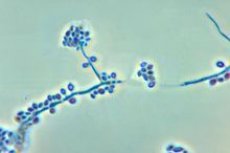Medical expert of the article
New publications
The causative agent of sporotrichosis (Sporothrix schenckii)
Last reviewed: 06.07.2025

All iLive content is medically reviewed or fact checked to ensure as much factual accuracy as possible.
We have strict sourcing guidelines and only link to reputable media sites, academic research institutions and, whenever possible, medically peer reviewed studies. Note that the numbers in parentheses ([1], [2], etc.) are clickable links to these studies.
If you feel that any of our content is inaccurate, out-of-date, or otherwise questionable, please select it and press Ctrl + Enter.

Sporothrix schenckii causes sporotrichosis (Schenck's disease), a chronic disease with local lesions of the skin, subcutaneous tissue and lymph nodes; damage to internal organs is possible. The pathogen was first described by Schenck in 1898.
Morphology and physiology
Sporothrix schenckii is a dimorphic fungus. In the patient's body, it grows in a yeast (tissue) form, forming cigar-shaped, oval cells with a diameter of 2-10 µm. Asteroid bodies (10-211 µm) are also detected. Asteroid bodies are formed by yeast-like cells and are surrounded by ray-like threads and rays. On a nutrient medium (Sabouraud glucose agar, 18-30 °C), the fungus forms folded white or dark colonies consisting of thin septate mycelium (mycelial form) with clusters of oval conidia in the form of daisy flowers. Sessile (on hyphae) conidia of a darker color are also found. Conidia (spores) are associated with hyphae-hairs, hence the name - Sporothrix.
Pathogenesis and symptoms of sporotrichosis
At the site of penetration of S. schenckii through damaged skin, an irregularly shaped ulcer, nodules and abscesses are formed. The fungus spreads lymphogenously. Nodules are formed along the proximal lymphatic tract with subsequent ulceration. The most common form of the disease is lymphatic (lymphocytic) sporotrichiosis. The affected areas are compacted and painless. Nodular skin lesions can also appear in mycobacterioses caused by opportunistic mycobacteria (M. marinum, etc.).
Sometimes the pathogen disseminates with the development of visceral sporotrichiosis: the lungs, skeletal system, abdominal organs and brain are affected. Primary pulmonary sporotrichiosis may also develop. During the disease, antibodies appear and DTH develops. Fungi are destroyed by neutrophils and macrophages.
Epidemiology of sporotrichosis
In the mycelial form, S. schenckii lives in soil and on rotting plant material; it is found in wood, water and air. It is widespread in the tropics and subtropics. People involved in agricultural work are most often affected. The pathogen enters areas of microdamage to the skin by contact (rose workers' disease). The fungus can penetrate intact skin or enter the lungs by an airborne mechanism.
Microbiological diagnostics of sporotrichosis
The discharge from ulcers, microabscesses, skin, lymph node and tissue punctures are examined. The preparations are stained with hematoxylin and eosin, Romanovsky-Giemsa, Gram-Weigert, and acridine orange. Microscopic examination of a smear or biopsy from the lesion reveals yeast-like cells and asteroid bodies of the fungus. A pure culture of the fungus in the form of a mycelial phase is isolated by culturing on nutrient media at 22-25 °C for 7-10 days (at 37 °C, the yeast form of the fungus develops). When the grown mycelium is administered intertesticularly to guinea pigs, it transforms into a yeast form. Antibodies to RA, RP, ELISA, etc. are sometimes detected in the blood serum of patients. An allergy test is performed with the allergen sporotrichin.


 [
[